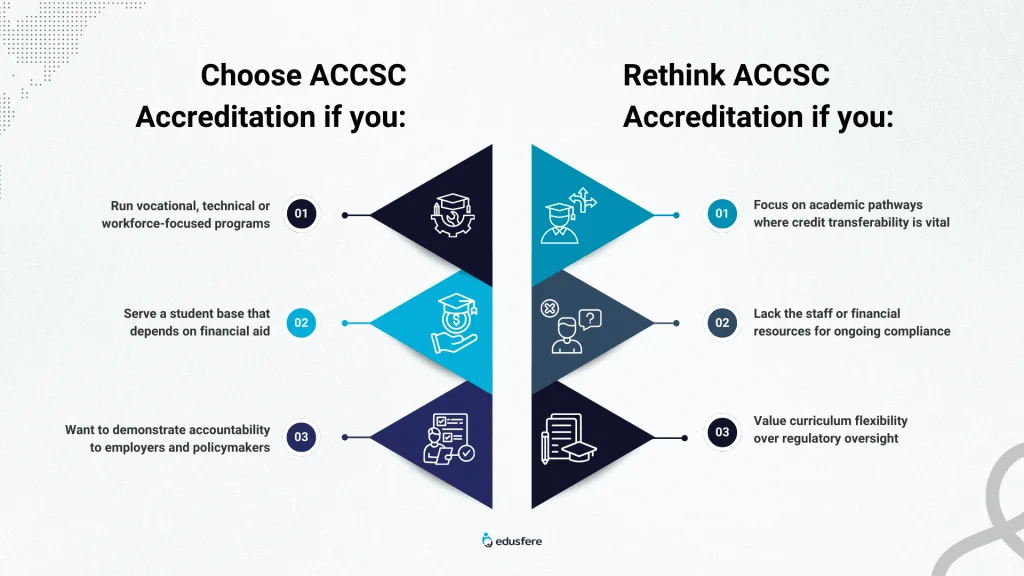Schedule a free demo to learn more
Is ACCSC Accreditation Good or Bad for Schools? What Every School Administrator Should Know
8th Sept 2025

Accreditation has long been a cornerstone of higher education in the United States, shaping how schools are evaluated and how students, employers and policymakers perceive their legitimacy. For vocational and career schools, this decision is even more critical because it directly influences access to federal aid, graduation outcomes and employability.
Among the different accreditation bodies, the Accrediting Commission of Career Schools and Colleges (ACCSC) has become a leading authority. But the ongoing debate remains: Is ACCSC accreditation good or bad for schools?
In this comprehensive guide, we’ll explore what ACCSC accreditation entails, why schools seek it, how it impacts curriculum providers and how it compares to other forms of accreditation.
What is ACCSC Accreditation?
Before weighing its pros and cons, it’s essential to understand what ACCSC accreditation really means. The ACCSC is a national accreditor recognized by the U.S. Department of Education. It specifically oversees postsecondary institutions that provide career, vocational and technical training, a space often underserved by traditional regional accreditors.
Currently, ACCSC accredits over 650 schools serving more than 150,000 students annually (ACCSC). Its mission is to ensure that institutions meet established standards in areas such as curriculum relevance, faculty qualifications, student outcomes and institutional integrity. For vocational schools, accreditation from ACCSC is often the gateway to both credibility and funding.
Why do schools seek ACCSC Accreditation?
Deciding to pursue accreditation is not just a compliance step; it’s a strategic choice that defines an institution’s trajectory. Schools seek ACCSC accreditation to build legitimacy, secure funding and differentiate themselves in a competitive marketplace.
One of the most significant motivators is access to Title IV federal financial aid, which only accredited institutions can provide. Without this, many students would be unable to pursue vocational education. Additionally, accreditation offers employers and students confidence that programs are aligned with workforce expectations. For curriculum providers, ACCSC offers a framework to design, evaluate and deliver programs that are industry-ready.
Is ACCSC Accreditation Good or Bad for Schools?
This is the million-dollar question that administrators often grapple with. Like any regulatory system, ACCSC accreditation has its benefits and drawbacks, and the real answer depends on your institution’s goals, resources and target student population. To get a complete picture, we must analyze both sides.
What Are the Benefits of ACCSC Accreditation?
The advantages of ACCSC accreditation are not abstract, they are tangible and measurable. For many schools, accreditation is the difference between thriving and struggling.
1. Credibility and Trust
Being accredited reassures prospective students and employers that your school meets recognized quality standards. Accreditation also strengthens relationships with curriculum providers, who can align their content with validated frameworks.
2. Access to Federal Student Aid
Perhaps the most powerful benefit is eligibility for Title IV aid. According to federal data, nearly 85% of students at career schools rely on financial aid—a lifeline only available if a school is accredited.
3. Demonstrable Outcomes
ACCSC requires institutions to track student outcomes. For example, Unitek College (an ACCSC-accredited institution) reported graduation rates of 67% to 81% and employment rates of 75% to 88% for its Medical Assisting program.
4. Industry Recognition
Institutions that excel can receive honors such as the ACCSC School of Excellence Award, reinforcing their market credibility.
5. Structured Accountability
Continuous evaluation means schools cannot remain stagnant; they must evolve with labor market needs, which ultimately benefits students.
What are the drawbacks of ACCSC Accreditation?
While the benefits are substantial, accreditation is not without its costs and challenges. Many administrators underestimate the financial and administrative burdens it introduces.
1. Compliance complexity
Accreditation requires meticulous documentation, regular reporting and site evaluations. For smaller institutions, these demands can be overwhelming.
2. Financial costs
From application fees to staff salaries dedicated to compliance, costs add up quickly. For some schools, accreditation can feel like a heavy investment with uncertain returns.
3. Limited recognition for transferability
Credits from ACCSC-accredited schools are often not accepted at regionally accredited universities, limiting mobility for students who may wish to pursue advanced degrees.
4. Mixed student outcomes
According to ProPublica, ACCSC-accredited schools have a graduation rate of 51% and a three-year default rate of 15%. While this is better than some national accreditors, it lags behind regionally accredited institutions.
How does ACCSC Accreditation affect curriculum providers?
Curriculum providers are not just passive players in the accreditation process, they are central to how schools meet standards. Accreditation demands that curriculum aligns with measurable learning outcomes, workforce relevance and competency-based assessments.
For providers, this creates both opportunities and limitations. On the positive side, accreditation validates their content as meeting high standards, increasing adoption by institutions. On the downside, rigid frameworks can stifle experimentation with emerging teaching models, such as adaptive learning or AI-driven simulations, unless carefully documented and justified.
How does ACCSC compare to other accreditors?
Choosing the right accreditor means understanding how ACCSC stacks up against other options. The differences between regional, national and specialized accreditors can significantly impact your school’s reputation and student mobility.
Regional accreditors are seen as the ‘gold standard,’ but ACCSC fills a crucial role for career and technical institutions. For administrators, the choice depends on whether your school prioritizes transferability or workforce readiness.
Should your school pursue ACCSC Accreditation?
Ultimately, the decision to pursue ACCSC accreditation should be guided by your school’s mission, resources and long-term vision. This isn’t a compliance checkbox, it’s a strategic commitment.

Choose ACCSC Accreditation if you:
- Run vocational, technical or workforce-focused programs
- Serve a student base that depends on financial aid
- Want to demonstrate accountability to employers and policymakers
Rethink ACCSC Accreditation if you:
- Focus on academic pathways where credit transferability is vital
- Lack the staff or financial resources for ongoing compliance
- Value curriculum flexibility over regulatory oversight
Is ACCSC Accreditation good or bad for schools?
For vocational and career-focused schools, ACCSC accreditation is generally a positive strategic move. It provides credibility, funding access and ensures accountability in student outcomes. However, data shows that accreditation doesn’t always guarantee return on investment for students and the compliance burden can be heavy.
For curriculum providers, ACCSC offers recognition and alignment with industry standards but may limit agility.
Here’s the bottom line. ACCSC accreditation is neither inherently good nor bad. Its value depends on whether it aligns with your institution’s mission, goals and operational capacity.
Still debating whether ACCSC accreditation is right for your school?
At Edusfere, we partner with administrators and curriculum providers to:
- Align programs with accreditation standards
- Streamline compliance processes
- Enhance student outcomes and workforce readiness
Accreditation is complex. But your school doesn’t have to navigate it alone.
At Edusfere, we help institutions align programs, strengthen curriculum and stay competitive in today’s dynamic education market.
Schedule a demo today to explore how Edusfere can support your school’s vision.